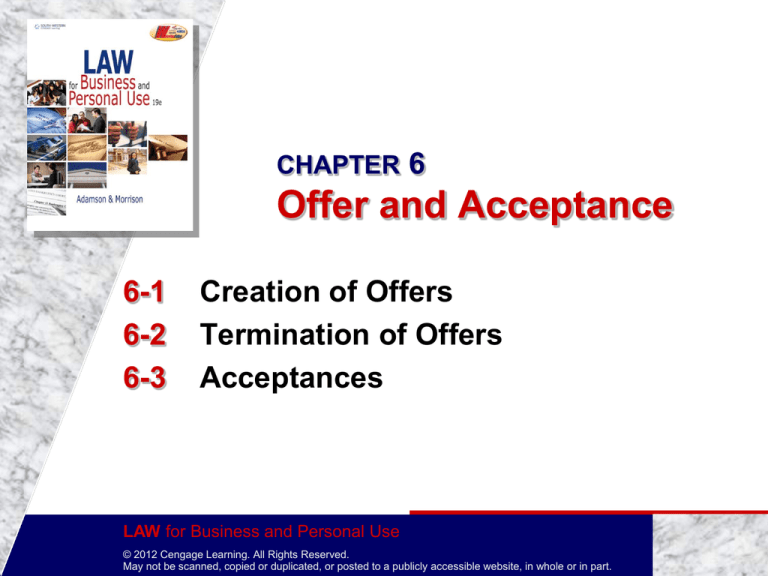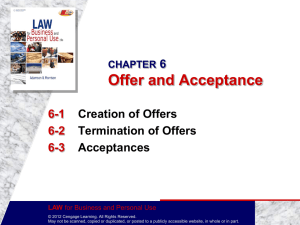
CHAPTER 6
Offer and Acceptance
6-1
6-2
6-3
Creation of Offers
Termination of Offers
Acceptances
LAW for Business and Personal Use
© 2012 Cengage Learning. All Rights Reserved.
May not be scanned, copied or duplicated, or posted to a publicly accessible website, in whole or in part.
6-1
Creation of Offers
GOALS
List the elements required to form a contract
Describe the requirements of an offer
Introduction to Contract Law
LAW for Business and Personal Use
Chapter 6
© 2012 Cengage Learning. All Rights Reserved.
May not be scanned, copied or duplicated, or posted to a publicly accessible website, in whole or in part.
SLIDE 2
REQUIREMENTS OF A LEGALLY
ENFORCEABLE CONTRACT
Offer and acceptance: contract must have an offeror
and an offeree.
Genuine assent: agreement by both parties.
Legality: terms of contract be of a legal nature.
Consideration: what is exchanged for promise.
Capacity: must have legal ability to contract.
Proper form: certain agreements must be in writing.
Contract law songs
LAW for Business and Personal Use
Chapter 6
© 2012 Cengage Learning. All Rights Reserved.
May not be scanned, copied or duplicated, or posted to a publicly accessible website, in whole or in part.
SLIDE 3
NATURE AND CLASSES OF CONTRACTS
Class 1:
Executed contracts: all promises met.
Executory contracts: something remains.
Class 2:
Express Contracts: terms expressly stated.
Implied-in-fact Contracts: terms are inferred.
Implied-at-law (quasi) Contracts: allows enforcement.
Class 3:
Unilateral contracts: promises something in return for
performance.
Bilateral contracts: mutual exchange
LAW for Business and Personal Use
Chapter 6
© 2012 Cengage Learning. All Rights Reserved.
May not be scanned, copied or duplicated, or posted to a publicly accessible website, in whole or in part.
SLIDE 4
REQUIREMENTS OF AN OFFER
Contractual intent must be present
Jests
Statements made in anger or terror
Preliminary negotiations
Social agreements
Offer must be communicated to the offeree
Essential terms must be complete and
definite
LAW for Business and Personal Use
Chapter 6
© 2012 Cengage Learning. All Rights Reserved.
May not be scanned, copied or duplicated, or posted to a publicly accessible website, in whole or in part.
SLIDE 5
6-2
Termination of Offers
GOALS
Describe the various ways to end offers
Explain how an offeree can ensure an offer will
remain open
Roommate Contract
LAW for Business and Personal Use
Chapter 6
© 2012 Cengage Learning. All Rights Reserved.
May not be scanned, copied or duplicated, or posted to a publicly accessible website, in whole or in part.
SLIDE 6
HOW CAN OFFERS BE ENDED?
Revocation by the offeror
Time stated in the offer
Reasonable length of time
Rejection by the offeree
Counteroffer My Cousin Vinnie
Death or insanity of either the offeror or
offeree
Destruction of the specific subject matter
LAW for Business and Personal Use
Chapter 6
© 2012 Cengage Learning. All Rights Reserved.
May not be scanned, copied or duplicated, or posted to a publicly accessible website, in whole or in part.
SLIDE 7
HOW CAN AN OFFER BE KEPT
OPEN?
Options: offeree gives offeror consideration
in return to keep offer open.
Firm offers: offer made in writing, stating how
long offer is to stay open.
LAW for Business and Personal Use
Chapter 6
© 2012 Cengage Learning. All Rights Reserved.
May not be scanned, copied or duplicated, or posted to a publicly accessible website, in whole or in part.
SLIDE 8
6-3
Acceptances
GOALS
Discuss the requirements of an effective
acceptance
Determine at what point in time an acceptance is
effective
LAW for Business and Personal Use
Chapter 6
© 2012 Cengage Learning. All Rights Reserved.
May not be scanned, copied or duplicated, or posted to a publicly accessible website, in whole or in part.
SLIDE 9
WHAT IS REQUIRED OF AN
ACCEPTANCE?
Acceptance must come from the person or
persons to whom the offer was made.
The acceptance must match the offer.
LAW for Business and Personal Use
Chapter 6
© 2012 Cengage Learning. All Rights Reserved.
May not be scanned, copied or duplicated, or posted to a publicly accessible website, in whole or in part.
SLIDE 10
WHAT IS REQUIRED OF AN
ACCEPTANCE?
Acceptance must be communicated to the
offeror:
Silence as acceptance
Promises as acceptance
Performance as acceptance
Modes of contractual communication
When acceptances are effective
LAW for Business and Personal Use
Chapter 6
© 2012 Cengage Learning. All Rights Reserved.
May not be scanned, copied or duplicated, or posted to a publicly accessible website, in whole or in part.
SLIDE 11
PREVENT
LEGAL
DIFFICULTIES
When you seek to enter into a contract . . .
When negotiating, assume the worst and include terms in
the contract addressing potential problems.
For important contracts, put offers and acceptances in
writing. If either an offer or an acceptance is made orally,
promptly confirm it in writing.
Obtain and keep a copy of every important document you
sign.
Express your intentions in offers and acceptances with
clear, complete, and understandable language.
Continued on the next slide
LAW for Business and Personal Use
Chapter 6
© 2012 Cengage Learning. All Rights Reserved.
May not be scanned, copied or duplicated, or posted to a publicly accessible website, in whole or in part.
SLIDE 12
PREVENT
LEGAL
DIFFICULTIES
Remember that the offeror may specify how and when the
offer must be accepted. Otherwise the offeree may use the
same means used by the offeror, a faster means, or other
reasonable means.
When appropriate, buy an option, if one is available, to
keep the offer open for as long as you need.
Remember that for an offeror to withdraw or revoke an
offer, the offeree must receive notice. For speed, use the
telephone, e-mail, or fax machine to withdraw or revoke an
offer.
LAW for Business and Personal Use
Chapter 6
© 2012 Cengage Learning. All Rights Reserved.
May not be scanned, copied or duplicated, or posted to a publicly accessible website, in whole or in part.
SLIDE 13









